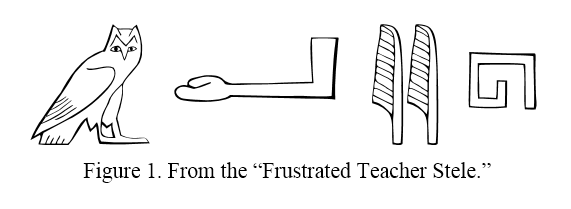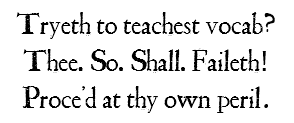For more than five thousand years, it was the world’s most perplexing mystery. The earliest known evidence of the riddle dates back to Egypt’s Early Dynastic Period, when a 10th-grade hieroglyphics teacher at Thutmosis High in Cairo carved four enigmatic symbols into a marble roll book. Though the translation of the symbols remains a source of fierce debate, most experts agree on some form of the following: “My students really hate learning vocab. How can I make vocabulary instruction engaging—for students and for me?”

This question, later dubbed the Vocab Conundrum, continued to plague educators for millennia, as evidenced by petitions etched in ancient runes, encrypted in medieval legal documents, and scrawled in the margins of Renaissance-era lesson planners.
In 1693, the Vocab Conundrum earned a new level of infamy when this cryptic haiku appeared on the wall of the staff lounge at Stratford-upon-Avon Middle School:

The haiku sent shivers of fear throughout Europe. Across the continent, vocabulary-related proscriptions were hastily passed. In the Ottoman Empire, the teaching of new words to anyone over the age of three was forbidden. In England, King William III levied an “etymology tax” on British colonists who dared teach word roots. In Salem Village, Massachusetts, harsh punishments were exacted on anyone teaching the difference between which and witch.
While the “Vocab Fright of 1693” eventually subsided, the view of vocabulary instruction as a joyless but necessary evil persisted for more than three centuries. Until 2017.
In that year, American educational publisher Prestwick House launched the first and second volumes of its Vocabulary in Context series, Wilderness Survival and The History of Hip-Hop. While the series offered many of the benefits of other programs, including high-stakes test prep, CCSS standards alignment, and a host of inferencing and context-based skills, it represented—as never before in history—a vocabulary program that was truly fun.
Now, teachers were writing messages like these:
The subject matter will interest students more than other [vocabulary resources].
[Students are] willing to learn the words to fully understand the readings. That’s a big plus.
Content students can relate to!
The Vocabulary in Context series not only eradicated the Vocab Conundrum; it irrevocably transformed the nature of vocabulary instruction.
Recently, Prestwick House announced it will release the third installment of the acclaimed series in July 2018, Mysteries, Curiosities & Wonders, a vocab-rich exploration of the most perplexing, bewildering, mystifying tales and phenomena ever discovered in a classroom.
Already, the book’s upcoming release has given rise to a new mystery&emdash;can Mysteries, Curiosities & Wonders be the single most effective and enjoyable vocabulary resource of all time?
The world is about to find out.
Mysteries, Curiosities & Wonders
Vocabulary in Context: Mysteries, Curiosities & Wonders introduces over 125 vocabulary words in the high-interest context of a book on unexplained mysteries and other phenomena, and uses research-based and classroom-proven lessons to make sure students remember the words they encounter.
Clicketh here to pre-ord'r Mysteries, Curiosities & Wonders